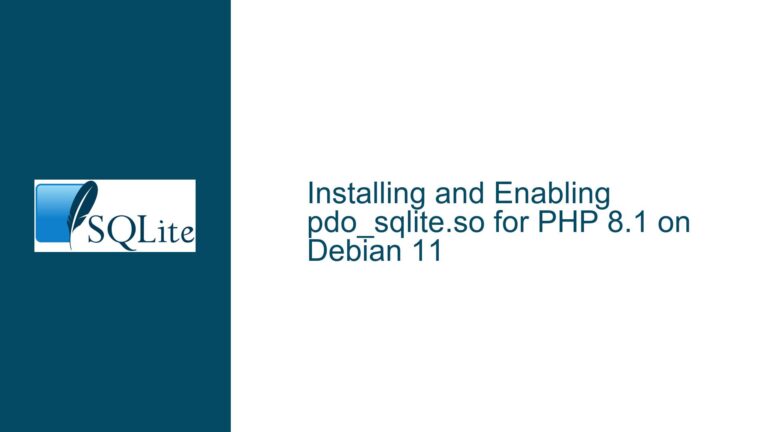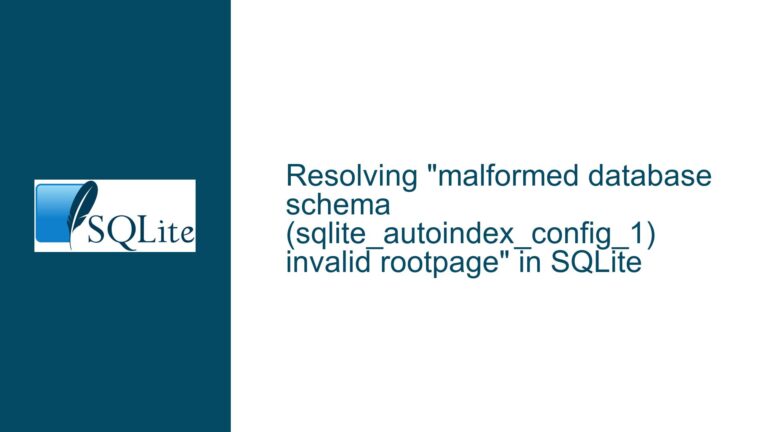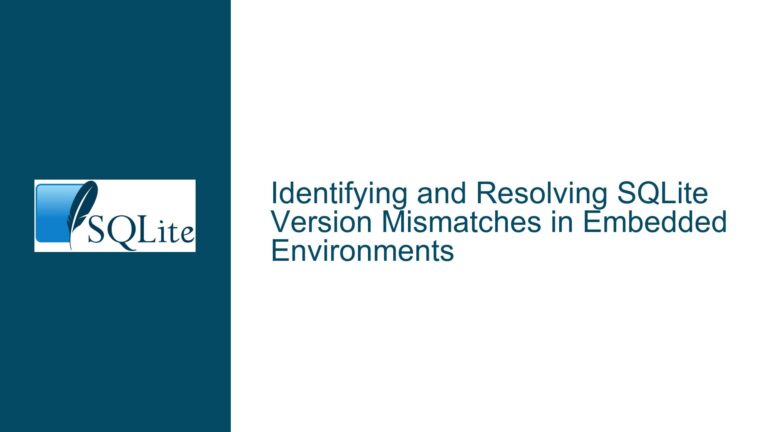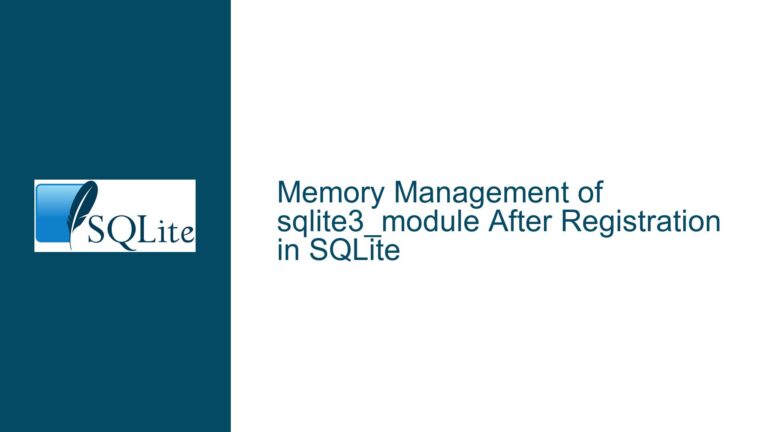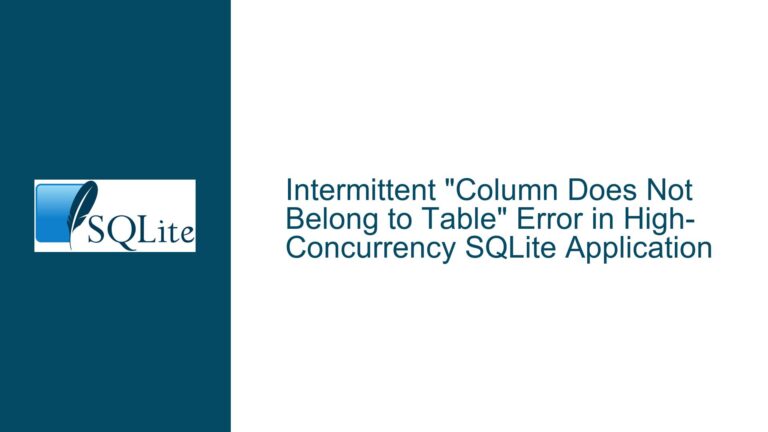SQLite Database File Locking Issues on Windows: Release & Delete Solutions
Database File Retention After Connection Closure: Diagnosis & Resolution
Incomplete Database Connection & Statement Finalization
When an application interacts with an SQLite database, every operation leaves traces in memory and file handles that require explicit cleanup. A common misconception among developers is that terminating the application or calling sqlite3_close() automatically releases all resources. While SQLite’s design prioritizes simplicity, its interaction with operating system file handling – particularly in Windows environments – introduces nuances that demand rigorous resource management.
The core challenge arises from SQLite’s layered architecture. Each database connection spawns internal structures: prepared statements, BLOB I/O streams, backup handlers, and journal file descriptors. Windows implements strict file locking semantics where any active handle (even from completed transactions) may retain locks until explicitly released. Unlike Unix-like systems that permit file deletion with open handles (via unlink() semantics), Windows blocks physical file removal until all handles close.
Deep Dive into Connection Lifecycle:
- Connection Initialization:
sqlite3_open_v2()creates a database handle linked to OS file handles - Statement Preparation:
sqlite3_prepare_v2()allocates memory buffers and ties them to the connection - Journal Management: Write-ahead logging (WAL) or rollback journals create auxiliary files
- Connection Closure:
sqlite3_close_v2()attempts to deallocate resources but fails if child objects remain
Critical failure points emerge when developers:
- Use
sqlite3_exec()without understanding its internal statement preparation - Forget to finalize interrupted/abandoned statements
- Omit error checking after close operations
- Misconfigure journal modes affecting file retention
Statement Lifecycle Example:
sqlite3 *db;
sqlite3_open("test.db", &db);
sqlite3_stmt *stmt;
sqlite3_prepare_v2(db, "SELECT * FROM tbl", -1, &stmt, NULL);
// ... execute ...
sqlite3_finalize(stmt); // Mandatory before close
sqlite3_close(db); // Fails with SQLITE_BUSY if stmt not finalized
Omission of sqlite3_finalize() leaves the statement active, blocking full connection closure. This manifests as persistent file locks even after sqlite3_close() returns success codes.
Diagnostic Techniques:
- Extended Error Codes: Check
sqlite3_extended_errcode()after close attempts - Connection Status: Use
sqlite3_db_status(db, SQLITE_DBSTATUS_LOOKASIDE_USED, ...)to detect active child objects - Windows Handle Inspection: Process Explorer’s "Handle" view shows open file handles by process
Common Oversights:
- Unreset cursors in iterative query loops
- Asynchronous operations that postpone statement finalization
- ORM layers that cache prepared statements
- Unreleased backup handles from
sqlite3_backup_init()
Developers must adopt a defensive coding style, treating every API call as potentially state-altering. Resource tracking containers (like C++’s RAII patterns) prove invaluable for ensuring deterministic cleanup across all code paths – including exception cases.
Journal Mode Configuration & Operating System File Locking Interactions
SQLite’s transactional integrity mechanisms directly influence file handle retention through journaling modes. The default DELETE mode creates transient -journal files during transactions, while WAL mode persists -wal and -shm files. Windows implements mandatory file locking that conflicts with these auxiliary files, creating complex interdependencies.
Journal Mode Characteristics:
| Mode | Journal Files | Locking Behavior | Delete Compatibility |
|---|---|---|---|
| DELETE | Temporary .journal | Single writer lock during writes | High |
| TRUNCATE | Empty journal via truncate | Similar to DELETE | Moderate |
| PERSIST | Persistent .journal | Long-term metadata locks | Low |
| WAL | .wal + .shm | Shared memory locks + write locks | Very Low |
| OFF | No journal | Risk of data corruption | Highest |
Windows-Specific Locking Nuances:
- Overlapped I/O: SQLite uses
LockFileEx()withLOCKFILE_FAIL_IMMEDIATELYflags - Lock Escalation: Read locks escalate to write locks during schema changes
- Handle Inheritance: Child processes may inherit open file handles
- Delayed Close: Windows defers physical file closure for caching purposes
In WAL mode, the shared memory file (.shm) memory-maps the database content, creating persistent handles that survive connection closure under heavy load. This explains why WAL databases exhibit more frequent locking issues during deletion attempts. The sqlite3_wal_checkpoint_v2() function must be invoked to reset the WAL file before closure.
Configuration Recommendations:
PRAGMA journal_mode = DELETE; -- For apps requiring frequent db deletion
PRAGMA locking_mode = EXCLUSIVE; -- Minimizes lock contention
PRAGMA temp_store = MEMORY; -- Avoid temp files in DELETE journal mode
Journal File Cleanup Sequence:
- Close all database connections
- Invoke
sqlite3_shutdown()to reset global state - Manually delete lingering .journal/.wal/.shm files
- Retry deletion with exponential backoff
Developers should implement file operation wrappers that handle ERROR_SHARING_VIOLATION (32) and ERROR_LOCK_VIOLATION (33) system errors, retrying with increasing delays. The Windows MoveFileEx() API with MOVEFILE_DELAY_UNTIL_REBOOT flag offers last-resort deletion during system restart.
Antivirus Interference & Filesystem Location Constraints
Third-party software – particularly real-time antivirus scanners – intercept file operations, injecting their own handles that prevent deletion. These scanners often memory-map database files for heuristic analysis, triggering Windows file locks indistinguishable from application holds. The NTFS filesystem’s opportunistic locking (oplocks) further complicates this by allowing clients to cache file states.
High-Risk File Locations:
- Program Files: Virtualization via UAC redirects writes to virtual store
- AppData\Local\Temp: Antivirus hot zones for incoming files
- Network Shares: Opportunistic locking with SMB leases
- OneDrive/Cloud Sync Folders: Background sync keeps files open
Mitigation Strategies:
- Exclusion Directories: Configure AV to ignore application-specific data folders
- File Streams: Use alternate data streams for metadata to avoid main file scans
- Handle Preemption: Open files with
FILE_SHARE_DELETEflag - Oplock Breaking: Periodically write to files to invalidate cached handles
Process Explorer Workflow:
- Launch as Administrator
- Ctrl+F search for the database filename
- Inspect holding process and handle type
- If handle belongs to non-critical process, close handle via right-click
- For system processes, identify root cause via stack trace
Code Snippet for Robust File Deletion:
#define MAX_RETRIES 5
#define RETRY_DELAY_MS 100
BOOL delete_file_robust(LPCSTR path) {
DWORD delay = RETRY_DELAY_MS;
for (int i = 0; i < MAX_RETRIES; ++i) {
if (DeleteFileA(path)) return TRUE;
DWORD err = GetLastError();
if (err != ERROR_SHARING_VIOLATION && err != ERROR_LOCK_VIOLATION) break;
Sleep(delay);
delay *= 2;
}
// Fallback to rename-and-delete
CHAR tmp[MAX_PATH];
if (GetTempFileNameA(".", "del", 0, tmp)) {
if (MoveFileExA(path, tmp, MOVEFILE_REPLACE_EXISTING)) {
MoveFileExA(tmp, NULL, MOVEFILE_DELAY_UNTIL_REBOOT);
return TRUE;
}
}
return FALSE;
}
Security Considerations:
- Avoid running applications with administrative privileges
- Store databases in
%USERPROFILE%\AppData\Local\YourApp - Use restricted SDDL ACLs to prevent other processes from opening files
- Prefer encrypted volumes for sensitive databases to deter AV scanning
NTFS Alternatives:
- Transactional NTFS (TxF): Atomic file operations (deprecated but functional)
- Sparse Files: Reduce actual disk footprint and scan surface
- Reparse Points: Redirect file access to alternate locations
By addressing these three core dimensions – connection lifecycle management, journal mode configuration, and environmental interference – developers can achieve reliable SQLite file deletion on Windows. Each layer requires meticulous attention to API usage patterns, system-level file semantics, and third-party software interactions. The solution space demands iterative testing with tools like Process Monitor (procmon) to capture real-time file system activity, coupled with structured exception handling in application code.

